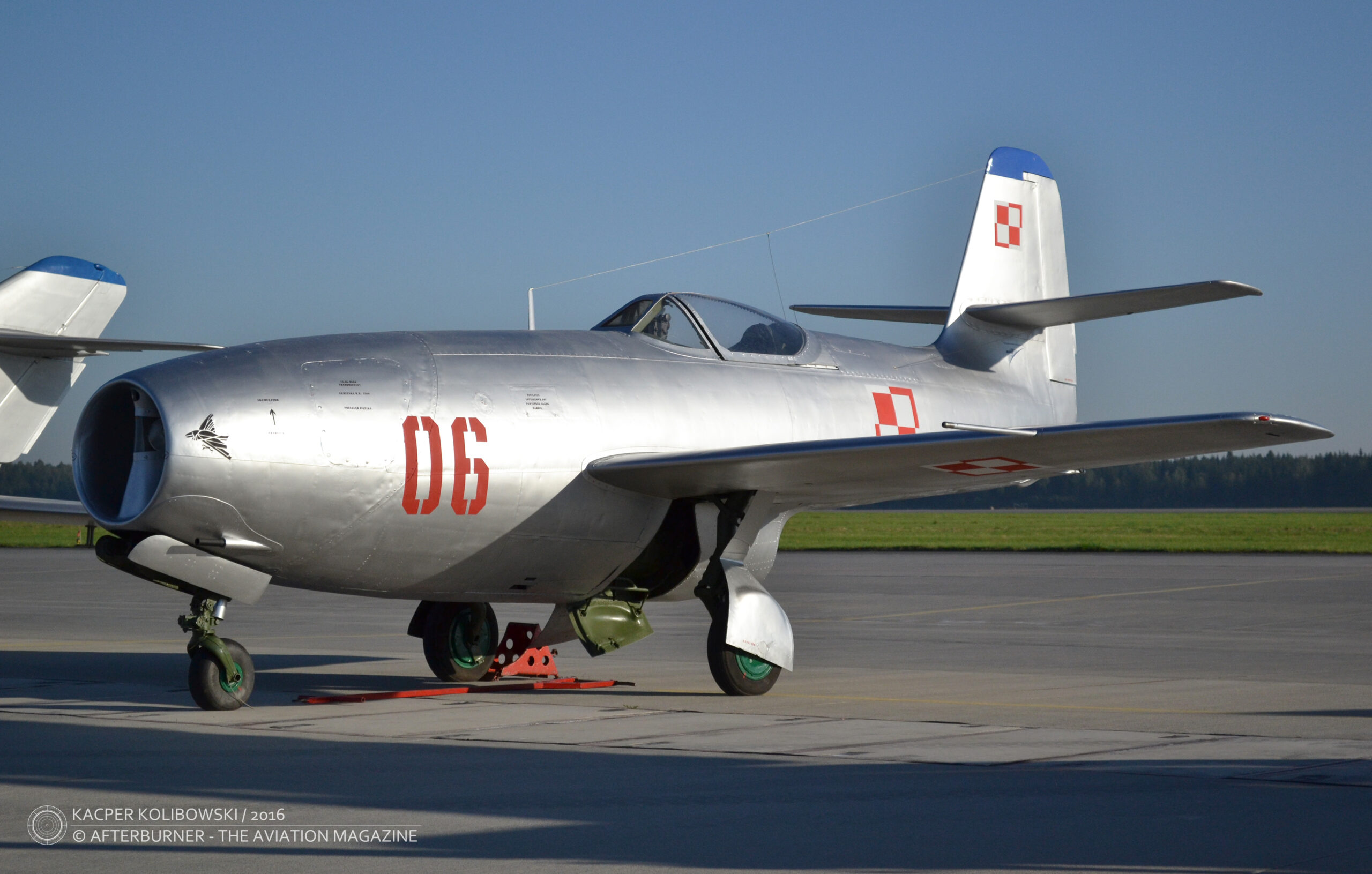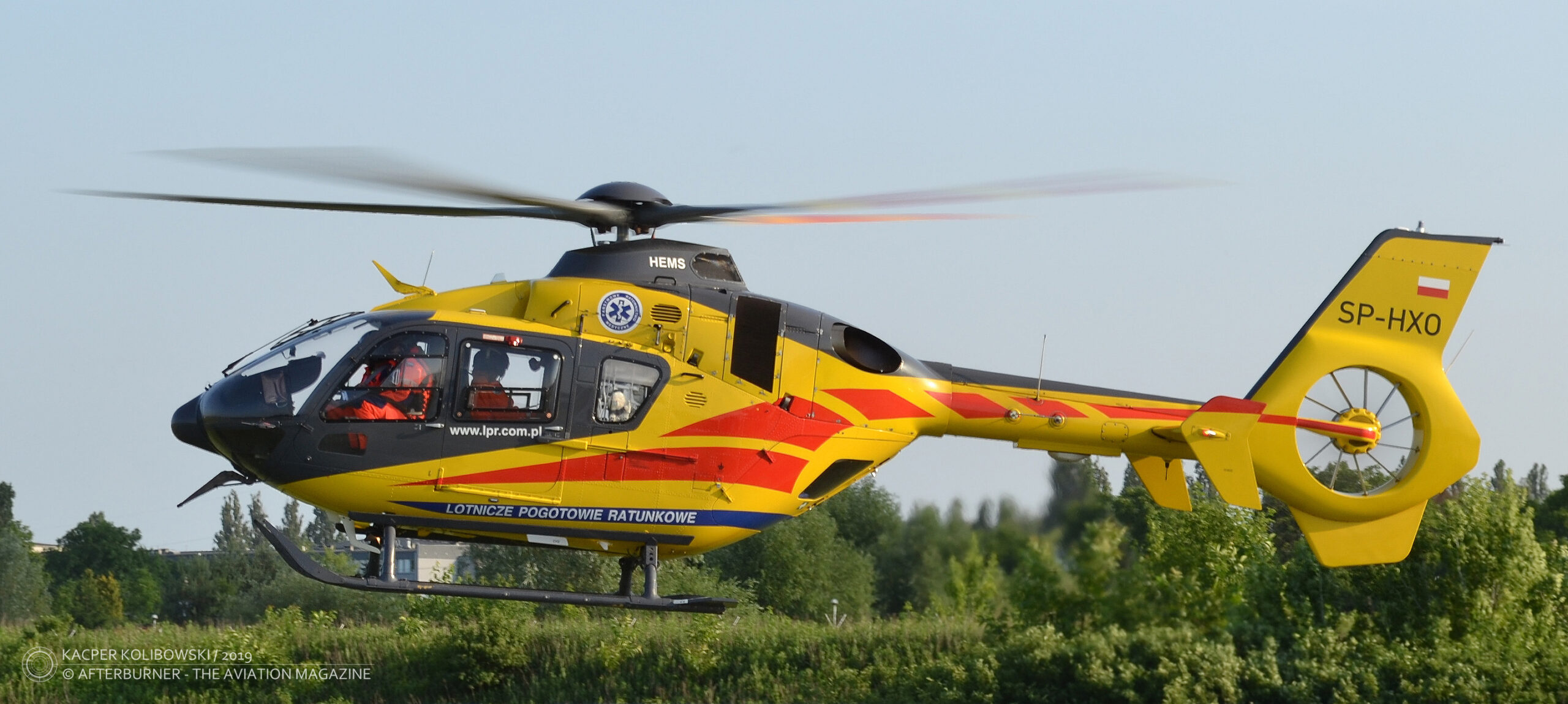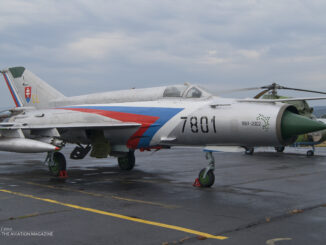
Yakovlev Yak-23 (NATO reporting name ´Flora´), Polish Air Force ´06´, exhibited at the static display during a joint event of the 10th anniversary of F-16 service in the Polish Air Force and the Polish Air Force Day, Krzesiny Air Base, 2016.
The Yak-23 was a light-weight jet fighter designed in the second half of the 1940s by Yakovlev construction bureau, following an initiative of its head, Alexander Sergeyevich Yakovlev. It was a direct development of Yak-15 and Yak-17 fighters, built shortly after the end of World War II.
When the works on Yak-23 began in late 1946, Yakovlev´s bureau was also working on another jet fighter, designated as Yak-25 and being developed in accordance to government requirements. Finally, the Soviet aviation authorities approved also the Yak-23 project, asking the constructor bureau to refine it until 30th July 1947.
Similarly to its predecessors, Yak-23 was an aircraft of quite unique design – with the jet engine placed in the nose section of the airframe and the nozzle located just below the pilot´s cabin. However, despite structural similarities with earlier developments, the new Yakovlev´s jet was a completely new aircraft with different characteristics.
In order to ensure the best performance of the new fighter aircraft, it was decided to reduce the weight of the airframe as much as possible. As a result, the aeroplane received just an absolute minimum of armour, the wing cover was also significantly reduced and – taking into consideration that Yak-23 had to be a low-and-medium ceiling fighter – an airtight cockpit was unnecessary.
New aircraft was powered by, at that time very powerful, RD-500 jet engine that provided a thrust of 15.6 kN and was a Soviet copy of Rolls-Royce Derwent Mk.V (an engine known for being used in Gloster Meteor jet).
The abovementioned deadline was met and the first prototype of Yak-23 was completed on 17th June 1947 and then performed its first flight on 8th July, flown by the Hero of the Soviet Union, pilot Lieutenant Colonel Mikhail Ivanov. Factory evaluation was finalized until 12th September and between November 1947 and March 1948, the second prototype of Yak-23 has undergone state tests, receiving very positive opinions. Regrettably, on 14th July 1948, the Yak-23-2 second prototype crashed, probably as a result of mid-air collision, killing Mikhail Ivanov.
Due to its light-weight construction and mentioned earlier, successful attempts to reduce the maximum weight of Yak-23 (1,980 kg unladen / 3,384 kg of maximum take-off weight with additional fuel tanks) and a powerful engine, the aircraft turned out to be highly manoeuvrable, had high acceleration and climbing speed; and, in addition, good take-off and landing characteristic and ability to operate from unpaved runways.
During one of the test flights, Yak-23 reached a speed of 932 kph, not only proving to be faster than other designs of the Yakovlev bureau, but even surpassing MiG-9 fighter jet.
Although, Yak-23 had also some disadvantages: poor longitudinal stabilization in flight at maximum speed (about 0.86 Ma), nose lift at a sudden increase of thrust (a result of downward deviation of the engine axis) and lack of aerodynamic brakes. All his made targeting and shooting with Yak-23 a quite difficult task. In addition, the absence of pressurized cockpit limited its practical use at higher altitudes.
Serial production of Yak-23 was launched in March 1948, approximately together with the production of MiG-15 and La-15 jets. However, the issues with RD-500 engine caused the delay in production and only in October 1949, the first serial Yak-23 left the aircraft production plant No. 31 in Tbilisi.
Both serial production and military service of Yak-23 were very short. The last aircraft were made by the end of 1950 after manufacturing of approximately 310 aeroplanes, including prototypes and two-seat training version designated as Yak-23UTI.
In the first half of 1950, twenty of early manufactured aircraft were assigned to the fighter aviation regiment based near Grozny, for military evaluation and testing. After concluding them successfully, Yak-23 entered operational service in aviation units of the North Caucasian and Volga Military District. Other aeroplanes were sent to the Soviet regiments stationed outside the USSR and also handed over to air forces of other Eastern bloc countries: Albania (1951), Bulgaria (1949), Czechoslovakia (1949), the Democratic People´s Republic of Korea, Hungary (1951) and Romania (1951).
Both Romania and Bulgaria worked on creating their own two-seat training variant and Czechoslovakia planned to start manufacturing Yak-23 under license (as S-101), but this project was later abandoned in favour of MiG-15.
Nevertheless, Poland was the largest user of Yak-23 outside the USSR. Approximately 100 of those fighters were operated by the Polish Air Force since 1951 – 90 purchased directly from the Soviet Union and another acquired from Czechoslovakia in 1953.
The first jet fighter in the Polish Air Force entered service in spring of 1951, for the first time being disclosed to public on 26th August 1951, during a military parade over Warsaw. However, also in Poland the military career of Yak-23 was very short and first aircraft were withdrawn from active service yet in 1954. They remained in military aviation schools and were used for training purposes until 1st September 1959, when all Yak-23s were officially retired.
An interesting fact is, that also Poland was going to launch production of Yak-23 under license. Those plans were formed in 1950 and the fighter, designated as G-3, had to be manufactured in WSK-Mielec aviation plant. Finally, similarly as with Czechoslovakia, this idea was abandoned in favour of the license production of MiG-15.
In 1956, two Yak-23s were donated to Institute of Aviation for testing purposed. Registered as SP-GLK and SP-GLL, the fighters started their second life in the civil aviation. On 21st September 1957, Andrzej Abłamowicz flying the SP-GLK set two world climbing records in this size class of aircraft: 3,000 metres in 119 seconds and 6,000 metres in 197 seconds.
SP-GLK was, most probably, the longest flying Yak-23 in the world, being retired on 28th November 1961. This aircraft can be still seen at the Institute of Aviation, where it is currently exhibited. Many other Yak-23s were preserved and today can be found at aviation monuments or in museums., however in different conditions.
The Yakovlev Yak-23 ´06´ pictured here, survived at the 31st Tactical Air Base in Poznań-Krzesiny, where it can be sometimes seen during events organized there.


